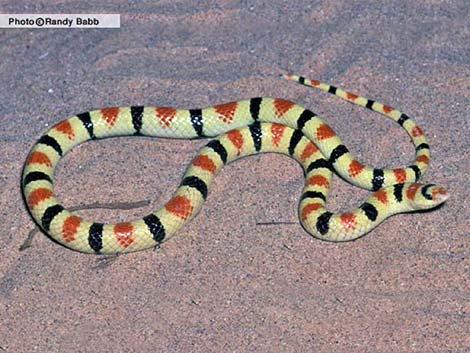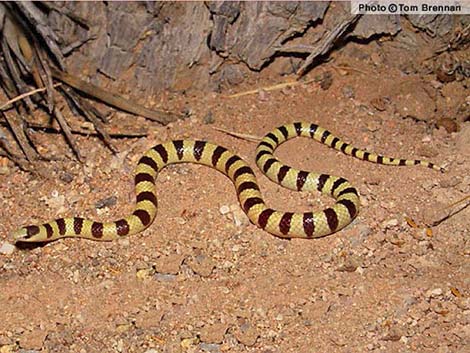
Nevada Shovel-nosed Snake (Chionactis occipitalis talpina)
Western Shovelnose Snake (Chionactis occipitalis)
Snakes Around Las Vegas, Wildlife Around Las Vegas
 Shovel-nosed Snakes can have black and red bands |
General Description: Shovel-nosed Snakes (Chionactis occipitalis) are small snakes, growing to about 18-inches long, with black and white, or black, white, and orange crossbars. The tip of the nose is white or red, but not black. Crossbars do not encircle the body. Shovel-nosed Snakes primarily live under ground in sandy places. The head is small and narrow, the snout is flattened, the body is more round than other snakes, and the scales are smooth, all of which apparently help them "swim" under the sand. Taxonomy: Colubrid Snakes Family (Colubridae). Diet: The diet consists mostly of invertebrates such as centipedes, spiders, moths, and scorpions. Habitat: Sandy areas (dunes, washes, flats) with little vegetation, but sometimes rocky hillsides. |
 Shovel-nosed Snakes sometimes lack red bands |
Range: Southern Nevada, southeastern California, southwestern Arizona, and northern Mexico. The Nevada Shovel-nosed Snake occurs in a small region of southwestern Nevada and southeastern California in Clark, Nye, and Inyo Counties. The Mojave Shovel-nosed Snake ranges more widely, occurring in southern California, the southern tip of Nevada, and western Arizona. Similar Species: This species can resemble a Coral Snake, but note that the tip of the nose on shovel-nosed snakes is not black. In Coral Snakes, black lips bring the kiss of death. Comments: Shovel-nosed snakes are nocturnal, burrowing creatures. During the day, they may lie just under the surface of the sand where they can get heat from the sun without being exposed to predators. They mostly forage for bugs under the sand, but they also come up at night to feed on the surface. |
Note: All distances, elevations, and other facts are approximate.
![]() ; Last updated 240708
; Last updated 240708
| Snakes Around Las Vegas | Wildlife Around Las Vegas | Glossary | Copyright, Conditions, Disclaimer | Home |